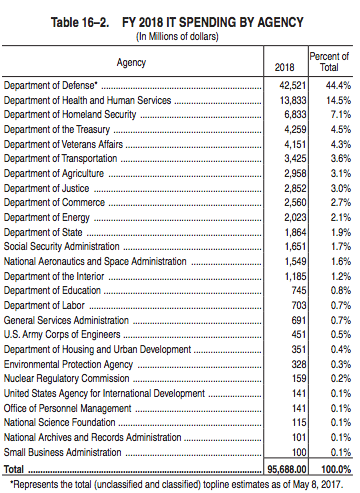Federal spending on information technology would increase 1.7 percent to $95.7 billion in fiscal 2018 under President Donald Trump’s budget proposal — up from $94.1 billion this year.
Nearly half of that funding — 42 percent — would go toward IT infrastructure, security and management efforts, including funding for “a central Technology Modernization Fund designed to improve the management and oversight of federal IT modernization projects,” according to budget documents released Tuesday.
As with any presidential budget, this is a starting point — something that Office of Management and Budget Director Mick Mulvaney acknowledged at a press briefing prior to releasing the budget. 
“Do I expect them to adopt this 100 percent, wholeheartedly, without any change?” said Mulvaney, who will be testifying on the Hill this week about the budget. “Absolutely not. Do I expect them to work with the administration on trying to figure out places where we’re on the same page? Absolutely. But I don’t think it invalidates the importance, the credibility of the president’s budget just because they’re not going to pass it wholeheartedly.”
But a number of the IT initiatives called out in the budget are efforts that began under the Obama administration, such as improving digital services, and extensions of ongoing efforts in Congress, including IT modernization. The latter received bipartisan support and led to the House passing an IT modernization bill this month.
Below are other key IT funding efforts and facts included in the president’s budget:
- If the president’s budget is approved, IT funding would actually exceed $95.7 billion. That figure doesn’t include small and independent agencies, national security systems and classified spending.
- The budget includes funding for 4,087 IT investments. These investments support four main functions: mission delivery; administrative services and support systems; IT infrastructure, IT security, and IT management; and grants and other transferred IT funding to non-federal organizations.
- The Defense Department accounts for 44.4 percent of the proposed $95.7 billion federal IT budget.
- The Health and Human Services Department has the largest IT budget among civilian agencies and accounts for 14.5 percent of the proposed tech budget. The bottom sixteen agencies collectively spend 10.7 percent of the IT budget.
- The budget calls for the creation of a central Technology Modernization Fund designed to improve the management and oversight of Federal IT modernization projects. The Technology Modernization Fund would be used by agencies to move from IT infrastructure, systems, and services that are not cost-effective or secure to more efficient and secure technologies. Agencies would be required to apply to and compete for modernization funds.
- The president’s budget proposal requires agencies to identify and budget for the modernization of specific high-risk, legacy IT systems, with a particular focus on moving those systems to cloud and shared services.
- Included in the budget are resources for digital services, such as funding for systems that will ensure veterans can easily access benefits and services, students can receive financial aid, and small business owners can access financing to start or expand their businesses. That means the administration will accelerate efforts to recruit top talent for programs like the U.S. Digital Service (USDS).
- There are also cyber program investments in the budget aimed at aligning budget resources with the National Institute of Standards and Technology (NIST) Cybersecurity Framework. The president’s cyber security executive order requires all agencies to adopt the Framework.
You can view the entire budget proposal here.





Leave a Reply
You must be logged in to post a comment.